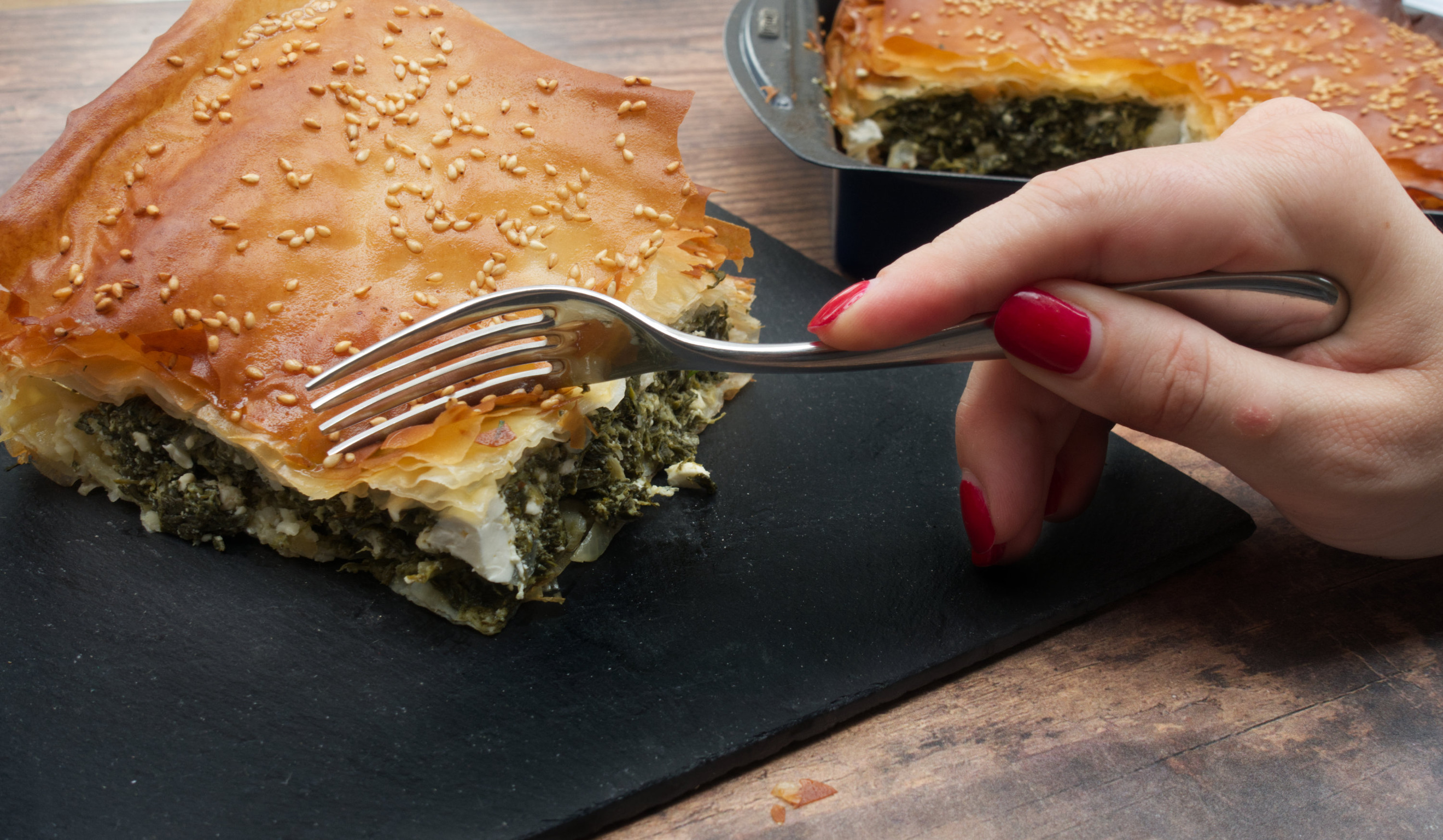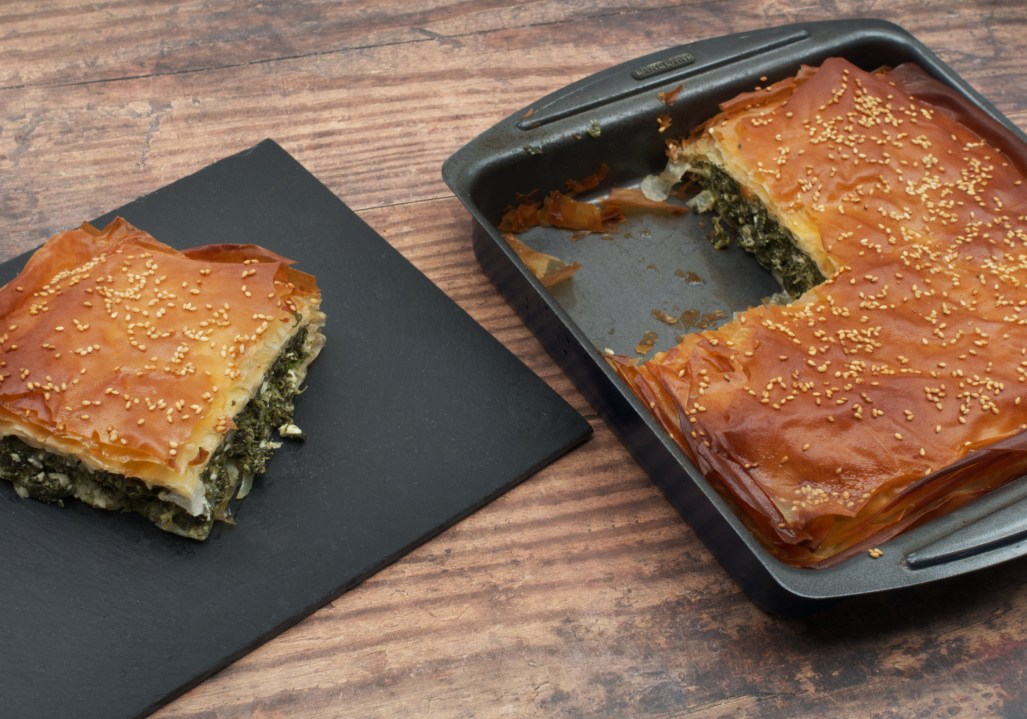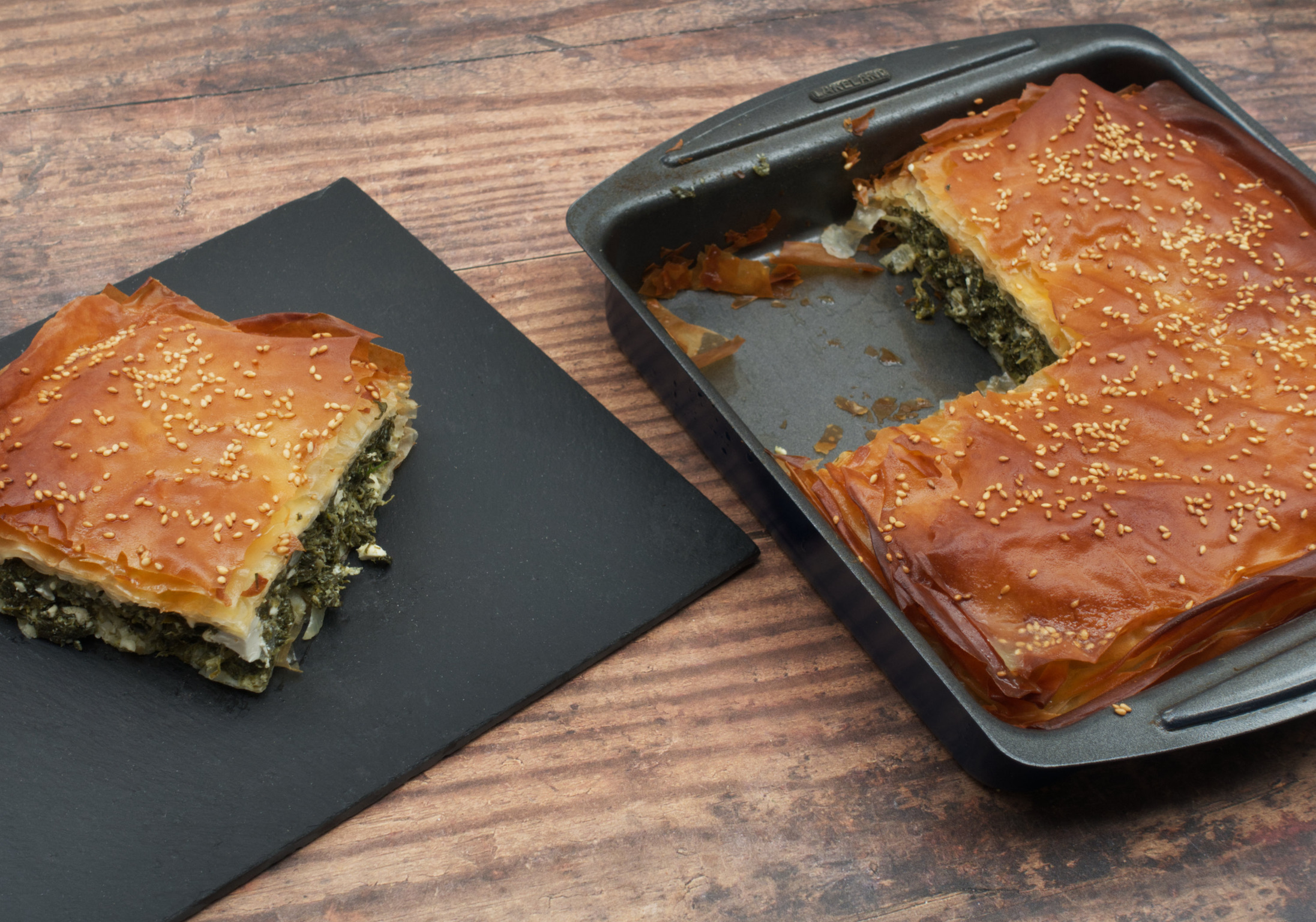There are few things more comforting than a pie, but often that level of comfort is directly proportional to the amount of effort required to make it. Pastry bases that must be prepared, then chilled, lined, blind baked and re-baked; fillings that require pre-cooking, or sauces that need thickening. Not so with spanakopita.
Spanakopita is a Greek cheese and spinach pie, encased in several layers of filo pastry, each sheet painted with butter or oil; once baked it is golden brown and crisp on the outside, and soft inside, fresh from the herbs, and rich and salty from the cheese. Filo is forgiving and easy to handle, the butter-brushing smoothing the filo into your pie dish, as well as bringing colour and flavour. The filling is made simply by stirring together the ingredients in a bowl and then spooning on top of the pastry. I suppose if you were making your own filo, it might not be quite such a cinch, but I’m no kitchen masochist, and certainly won’t be suggesting you do so here (or ever, frankly). Without that labour, it is an easy and speedy delight, a pie that is big on flavour and texture and comfort, with a fraction of the faff.
You can shape your spanakopita in a variety of ways: in big round or square baking pans, smooth-topped, and pre-cut before cooking, to help you portion once the filo is baked and brittle; or rolled into a sausage, and then wound into a beautiful, burnished spiral. Or you can make mini versions – spanicopitakia – little samosa-like triangles, cigars, or folded over and rounded, like little pasties. The recipe below is for the first version, but it will translate to the others; just start checking the smaller pastries after 20 minutes, they are ready when they are golden and crisp.
The key to a good spanakopita is to make sure that the spinach is as dry as possible before it goes into the pie. Soggy spinach makes for sad spanakopitas; bland and sloppy. This is easier said than done: spinach loves to hold onto water, weeping gently, and diluting flavour. You can still achieve dryness with fresh spinach, but it needs cooking first, and it can be hard to predict how much you need to fill a pie. The cliché of piling two bin bags’ worth of raw spinach into a pan, and cooking it, only to find you’ve produced a teaspoon’s worth, is scant exaggeration. For this reason, I use frozen spinach. The key advantage of frozen spinach is that it has already been cooked and is therefore extremely compact; the flavour difference is negligible, especially once the spinach is combined with soft, fragrant herbs, gently fried onion, and a tonne of cheese.
The filling needs judicious seasoning: the feta will bring saltiness, but spinach can take a lot of salt, and a good grinding of black pepper and the lemon juice and zest can really lift the pie and bring the herbs to life. I like to add the egg and egg yolk last, so that, before that addition, I can taste, season, and repeat if necessary to make sure that the filling is bright and fragrant, rich and complex.

Spanakopita
Makes: Serves 6
Takes: 15 minutes
Bakes: 30 minutes
½ a large onion, finely chopped
1 tablespoon olive oil
1kg frozen spinach, defrosted and drained
300g feta cheese
1 egg
1 egg yolk
30g Parmesan, grated
1 lemon, zested and juiced
Fistful of mint, finely chopped
Fistful of parsley, finely chopped
Fistful of dill, finely chopped
¼ teaspoon grated nutmeg
250g filo pastry
100g butter, melted
2 tablespoons sesame seeds
- Preheat the oven to 200°C. Place the olive oil in a saucepan and gently cook the onion until softened but not coloured.
- Give the drained, defrosted spinach a good squeeze and place it in a large bowl.
- Crumble the feta into the spinach, and add the parmesan, lemon zest, 2 tablespoons of lemon juice, all the herbs, the nutmeg, and the softened onion, and season it generously with salt and black pepper. Add the egg and egg yolk, then give the mixture a really good mix, to make sure that everything is evenly distributed.
- Place a sheet of filo in a large roasting pan, at least 9×9 inches, or 10 inches if round, and brush it with the melted butter. Place another sheet of filo on top, and brush with butter again. Repeat with more sheets and more butter, until you have used half of the filo. Spoon the mixture on top of the filo in a dense, even layer. Place a sheet of filo on top of the filling, and brush it with butter; continue with the remaining filo and butter until you have used up all the pastry. Drizzle any remaining butter onto the top of the pie, and sprinkle with sesame seeds. Slice the uncooked pie into 6-8 slabs, depending on how generous or greedy you and your guests are feeling; this will really help the spanakopita to come out cleanly once baked.
- Bake for 30-40 minutes, until the filo is golden brown. Leave to cool for 30 minutes, before running your knife through the cut marks you made before cooking, lift out and serve.







Comments